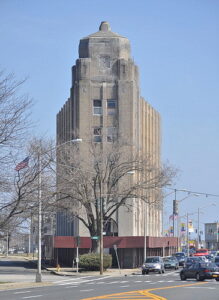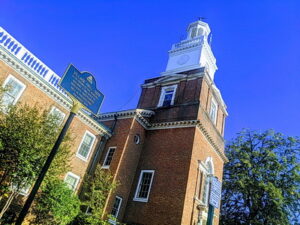
(L) Freeport Long Island water tower from Sunrise Highway (R) Map of NYS and Nassau Country with Freeport highlighted in red
Freeport History
Nestled on the South Shore of Long Island, Freeport conveys a tale of transition. Once a bustling oyster hub and theatrical retreat, it now navigates the currents of suburban life, balancing its historic ocean charm with the realities of change.
Freeport’s story begins in the 1640s when Dutch settlers discovered the bounty of its oyster beds. The industry thrived, shaping the community’s character and economy for centuries. Shucking houses lined the waterfront, and the “Freeport Oyster” became a renowned delicacy.
By the late 19th century, the village transformed. Its picturesque location and proximity to New York City attracted vacationers, particularly actors seeking solace from the city’s hustle and bustle. The Freeport Playhouse, built in 1928, remains a testament to this era, hosting renowned performers and fostering a love for the arts.
The 20th century ushered in further change. Freeport evolved into a bedroom community, with residents commuting to nearby urban centers. In 1937, the town population surpassed 20,000 making it the largest village in Nassau County. While the oyster industry dwindled, light industry and retail businesses flourished, creating a vibrant downtown district.
Architecture

The village contains many colonial-style homes with other architectural styles dotted around. Notably, many homes that are near the water have their first floor raised a few feet with some built on stilts.
Residents of Freeport and those who routinely travel along Sunrise Highway are no doubt familiar with the art-deco Meadowbrook Bank Building which was located near the LIRR Freeport station. It was vacant for a long time and then demolished in December 2019 for the building of a car dealership, which is currently underway.
Today
The Freeport is undergoing a revitalization. Efforts to restore the historic charm of the downtown area are evident in the revitalization of Merrick Road, lined with charming shops and restaurants.
What Freeport is most famous for these days is the iconic Nautical Mile, boasting fine seafood restaurants, marinas, and boatyards, and is experiencing a renaissance, attracting more boaters and tourists.
Beyond its physical transformation, Freeport’s heart lies in its diverse and engaged community. The annual boat parade reflects the village’s unique spirit.
Community

Education remains a priority, with Freeport Public Schools offering a range of programs and opportunities for students. The presence of Hofstra University adds an intellectual and cultural vibrancy to the village.
The Future
Looking ahead, Freeport’s future holds promise. The continued revitalization efforts, coupled with a strong community spirit, position the village for a thriving future. Its proximity to New York City, coupled with its own evolving identity, makes it an attractive destination for young professionals and families seeking a vibrant yet close-knit community.
Conclusion
Freeport, New York, is a microcosm of Long Island’s transformation. It embodies the beauty and challenges of reinvention, striving to preserve its heritage while embracing the future. It’s a place where the salty tang of the past mingles with the fresh breeze of change, creating a unique and ever-evolving community. As Freeport navigates its journey, one thing remains certain: its charm, resilience, and community spirit will continue to be its guiding stars.
Patricia Scanlon is a traffic ticket attorney who services clientele in Freeport and the entire Long Island and NYC area.